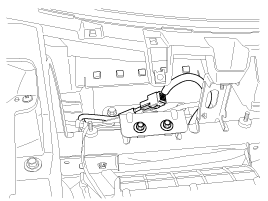 Hyundai Sonata: Passenger Airbag (PAB) Module. Repair procedures
Hyundai Sonata: Passenger Airbag (PAB) Module. Repair procedures
Removal
| 1. |
Disconnect the battery negative cable and wait for at least three
minutes before beginning work.
|
| 2. |
Remove the glove box housing. (Refer to the Body group- crash
pad).
|
| 3. |
Disconnect the passenger airbag connector and remove the PAB mounting
bolts.
|
| 4. |
Remove the crash pad. (Refer to the Body group- crash pad).
|
| 5. |
Remove the heater duct from the crash pad.
|
| 6. |
Remove the mounting bolts from the crash pad. And then remove
the passenger airbag.
|
Installation
| 1. |
Remove the ignition key from the vehicle.
|
| 2. |
Disconnect the battery negative cable from battery and wait for
at least three minutes before beginning work.
|
| 3. |
Place the passenger airbag on the crash pad and tighten the passenger
airbag mounting bolts.
|
| 4. |
Install the heater duct to the crash pad.
|
| 5. |
Install the crash pad. (Refer to the Body group- crash pad)
|
| 6. |
Tighten the passenger airbag crash pad mounting bolts.
|
| 7. |
Connect the passenger airbag harness connector to the SRS main
harness connector.
|
| 8. |
Reinstall the glove box. (Refer to the Body group- crash pad)
|
| 9. |
Reconnect the battery negative cable.
|
| 10. |
After installing the passenger airbag (PAB), confirm proper system
operation:
|
 Side Airbag (SAB) Module. Description and Operation
Side Airbag (SAB) Module. Description and Operation
Description
The Side Airbags (SAB) are installed inside the front seat and protects
the driver and passenger from danger when side crash occurs. The SRSCM determines
deployment of side airba ...
See also:
Specifications
Specifications
Item
Specification
Power source
DC 14.4V (-) ground
Frequency range / Channel space
FM : 87.9 ~ 107.9 ...
Oil Pressure Switch. Repair procedures
Inspection
1.
Check the continuity between the terminal and the
body with an ohmmeter.
If there is no continuity, replace the oil pressure
switch.
...
Components and Components Location
Component Location
1. Audio unit
2. Midrange speaker
3. External amplifier
4. Glass antenna (AM/FM)
5. Front door speaker
6. Rear door speaker
7. Woofer s ...


